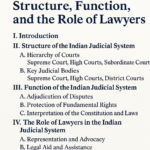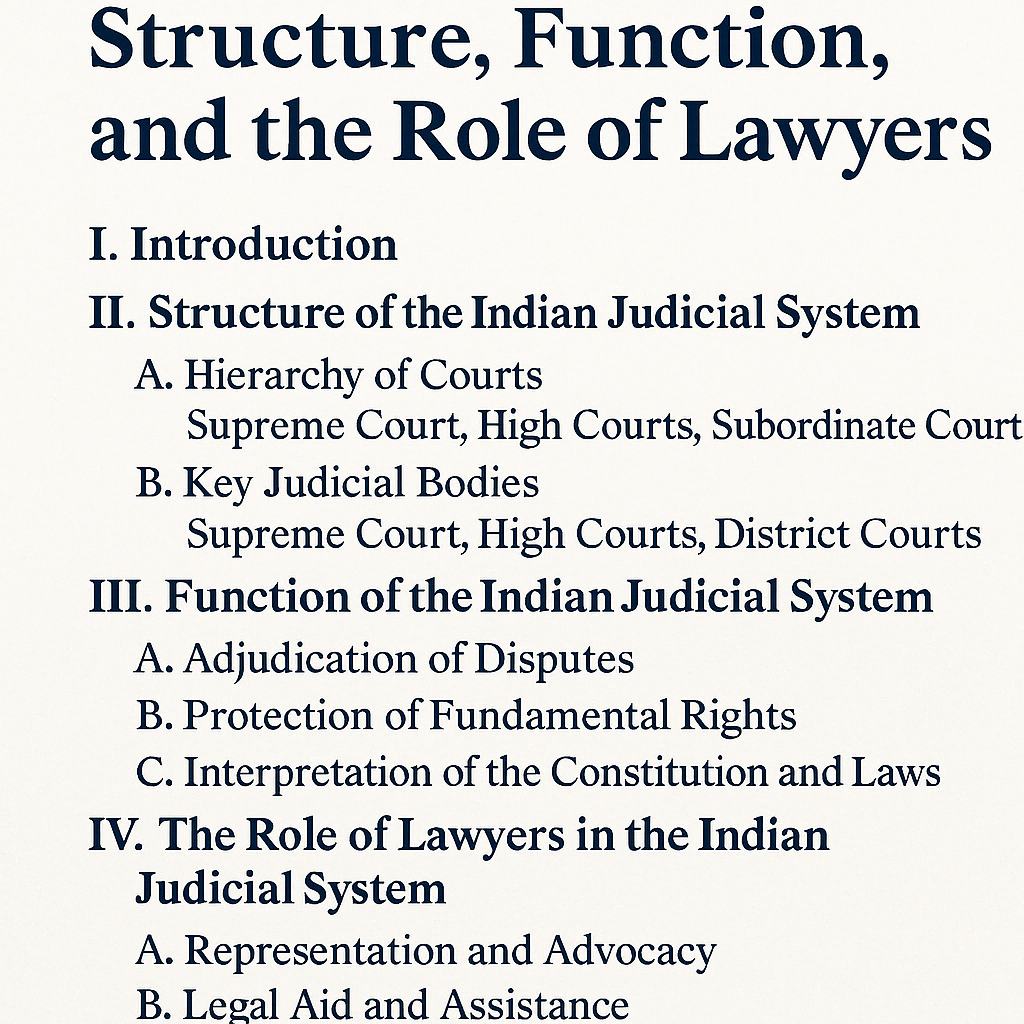
Introduction ;
The Indian judicial system is one of the most intricate and expansive legal systems in the world. It serves as the guardian of the Constitution and the protector of the rights of individuals. With a rich history rooted in colonial legacy and influenced by common law traditions, it has evolved into a robust institution committed to justice, equality, and fairness. This comprehensive exploration aims to delve into the structural hierarchy of the judiciary, its multifaceted functions, and the indispensable role played by lawyers.
1.Historical Evolution of the Indian Judicial System
Post-independence:_Adoption of the Constitution of India and establishment of an independent judiciary
Ancient Indian judicial practices: Dharmashastra and customary laws
Mughal legal system: Qazis and Islamic jurisprudence
British colonial period: Introduction of common law, codification, and the establishment of formal courts
2. Constitutional Framework of the Indian Judiciary
- Separation of powers and independence of the judiciary
- Articles 124 to 147 (Supreme Court), 214 to 231 (High Courts), and 233 to 237 (Subordinate courts)
- Judicial review and the supremacy of the Constitution
3. Structure of the Indian Judicial System
Tribunals and special courts: NCLT, CAT, Consumer courts, and others
Supreme Court of India: Composition, jurisdiction (original, appellate, advisory), and powers
High Courts: Jurisdiction, powers, and supervisory role
Subordinate Courts: District courts, Sessions courts, Civil and Criminal courts, Family courts, and Lok Adalats

4. Functions of the Indian Judiciary
Public interest litigation (PIL) and judicial activism
Interpretation and guardian of the Constitution
Protection of fundamental rights
Adjudication of civil and criminal cases
Judicial review of legislative and executive actions
5. Role of the Supreme Court and Landmark Judgments
Navtej Singh Johar v. Union of India (2018) – Decriminalization of Section 377
Kesavananda Bharati v. State of Kerala (1973) – Basic Structure Doctrine
Maneka Gandhi v. Union of India (1978) – Expansion of Article 21
Vishaka v. State of Rajasthan (1997) – Sexual harassment guidelines
6. High Courts and Their Regional Influence
Contribution to legal development through regional judgments
Role in protecting legal rights at the state level
Superintendence over subordinate courts
7. Subordinate Judiciary: Backbone of the Legal System
- Role in delivering justice at the grassroots level
- Challenges: Pendency, lack of infrastructure, judicial vacancies
- Reforms and digitization efforts
8. Alternative Dispute Resolution (ADR) and Tribunals
Effectiveness and concerns
ADR methods: Mediation, conciliation, arbitration, negotiation
Role of tribunals in easing court burden
10. Legal Profession in India: Challenges and Opportunities
- Access to justice and legal literacy
- Gender and caste representation
- Globalization and legal tech
- Reforms in legal education and practice
11. Judicial Reforms and Future Outlook
Role of judiciary in a changing socio-political context
Increasing judicial strength and infrastructure
Case management and technology adoption
Transparency, accountability, and the collegium system
Conclusion The Indian judicial system stands as a pillar of democracy and the rule of law. Despite its challenges, it continues to evolve, adapting to the dynamic needs of society. Lawyers, as key players in this system, not only ensure justice but also contribute to the shaping of a fairer, more inclusive society. Continued reforms, enhanced public trust, and technological integration will be critical in strengthening the judiciary’s role in the years to come.